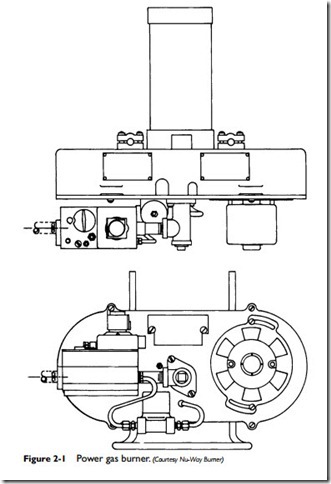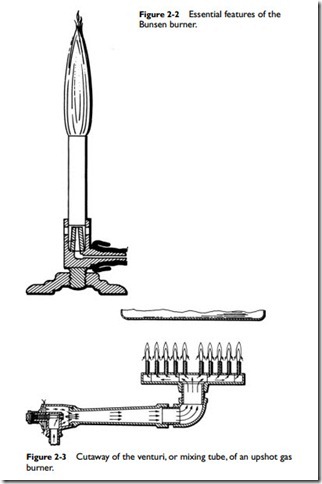A gas burner (see Figure 2-1) is a device for supplying gas, or a mixture of gas and air, to the combustion area. Those used in residential and light commercial heating are most commonly high-pressure, gun-type burners. Only those gas burners approved by the American Gas Association (AGA) should be used in a heating system.
Gas is used as a heating fuel in both urban and rural areas. Manufactured, natural, and bottled gas are the three types used as heating fuels. Each of these gases has different combustion characteristics and will have different heat values when burned. Because of this, a gas burner must be adjusted for each gas fuel, particularly when changing from one type to another. The principal types of bottled gas used as heating fuels are propane and butane. Bottled gas is frequently called LPG (liquefied petroleum gas) and is widely used as a heating fuel in rural areas. A more detailed description of heating fuels is found in Chapter 5 of Volume 1 (Heating Fuels).
Operating Principles
The gas burners used in residential heating systems are most commonly the atmospheric injection type that operates on the same principle as the Bunsen burner.
The essential features of the Bunsen burner are shown in Figure 2-2. The burner consists of a small tube or burner, which is placed inside a larger tube. The latter has holes positioned slightly below the top of the small tube. The gas escaping from the small tube draws the air in through the holes and produces what is called an induced current of air in the large tube. This air enters through the holes and is mixed with the gas in the tube. The mixture is burned at the top of the larger tube. The flame from such a burner gives hardly any light, but the heat is intense. The intensity of the heat can be illustrated by holding a metal wire over the flame for a few seconds. It will glow with heat in a very short time.
The air supply in an atmospheric injection burner is classified as either primary or secondary air and is commonly introduced and mixed with the gas in the throat of the mixing tube. The cutaway of an upshot atmospheric gas burner in Figure 2-3 illustrates this principle of operation. The gas passes through the small orifice in the mixer head, which is shaped to produce a straight-flowing jet moving
at high velocity. As the gas stream enters the throat of the venturi, or mixing tube, it tends to spread and induce air in through the opening at the adjustable air shutter. The energy in the gas stream forces the mixture through the mixing tube into the burner manifold casting, from which it issues through ports where additional air must be added to the flame to complete combustion. The air coming in through the venturi is the primary air and that supplied around the flame is the secondary air.
The primary air is admitted at a ratio of about 5 parts primary air to 1 part gas for manufactured gas, and a 10 to 1 ratio for natu- ral gas. These ratios are generally used as theoretical values of air for purposes of complete combustion. Most atmospheric injection burners operate efficiently on 40 to 60 percent of the theoretical value.
The excess air required depends on several factors, notably the following:
• Uniformity of air distribution and mixing
• Direction of gas travel from the gas burner
• The height and temperature of the combustion chamber
The secondary air is drawn into the burner by natural draft. Excess secondary air constitutes a loss and should be reduced to a proper minimum (usually not less than 25 to 35 percent). All yellow-flame gas burners depend exclusively on secondary air for combustion.
The Bunsen burner flame is bluish and practically nonluminous. A yellow flame indicates dependence entirely on secondary air for combustion. Primary air is regulated by means of an adjustable shutter. For manufactured gas, the air supply is regulated by clos- ing the air shutter until yellow flame tips appear and then by open- ing the air shutter to a final position at which the yellow tips just disappear. This type of flame obtains ready ignition from port to port and favors quiet flame extinction. When burning natural gas, the air adjustment is generally made to secure as blue a flame as possible.
The division of air into primary and secondary types is a matter of burner design, the pressure of gas available, and the type of flame desired.
The gas should flow out of the burner ports fast enough so that the flame cannot travel or flash back into the burner head. The velocity must not be so high that it blows the flame away from the port. In an all-yellow flame, flame flashback cannot occur, and a much higher velocity is needed to blow off the flame.
A draft hood is used to ensure the maintenance of constant low- draft conditions in the combustion chamber with a resultant stability of air supply. A draft hood will also control backdrafts that tend to extinguish the gas burner flame and the amount of excess air. These draft hoods must conform to American Standard Requirements.

